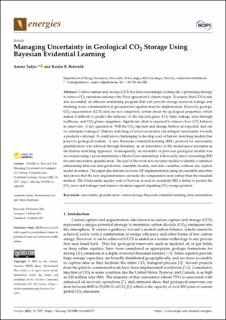| dc.contributor.author | Bratvold, Reidar Brumer | |
| dc.contributor.author | Tadjer, Amine | |
| dc.date.accessioned | 2021-06-08T08:08:43Z | |
| dc.date.available | 2021-06-08T08:08:43Z | |
| dc.date.created | 2021-05-25T17:15:01Z | |
| dc.date.issued | 2021-03 | |
| dc.identifier.citation | Tadjer, A., Bratvold, R.B. (2021) Managing Uncertainty in Geological CO2 Storage Using Bayesian Evidential Learning. Energies, 14(6), 1557 | en_US |
| dc.identifier.issn | 1996-1073 | |
| dc.identifier.uri | https://hdl.handle.net/11250/2758439 | |
| dc.description.abstract | Carbon capture and storage (CCS) has been increasingly looking like a promising strategy to reduce CO2 emissions and meet the Paris agreement’s climate target. To ensure that CCS is safe and successful, an efficient monitoring program that will prevent storage reservoir leakage and drinking water contamination in groundwater aquifers must be implemented. However, geologic CO2 sequestration (GCS) sites are not completely certain about the geological properties, which makes it difficult to predict the behavior of the injected gases, CO2 brine leakage rates through wellbores, and CO2 plume migration. Significant effort is required to observe how CO2 behaves in reservoirs. A key question is: Will the CO2 injection and storage behave as expected, and can we anticipate leakages? History matching of reservoir models can mitigate uncertainty towards a predictive strategy. It could prove challenging to develop a set of history matching models that preserve geological realism. A new Bayesian evidential learning (BEL) protocol for uncertainty quantification was released through literature, as an alternative to the model-space inversion in the history-matching approach. Consequently, an ensemble of previous geological models was developed using a prior distribution’s Monte Carlo simulation, followed by direct forecasting (DF) for joint uncertainty quantification. The goal of this work is to use prior models to identify a statistical relationship between data prediction, ensemble models, and data variables, without any explicit model inversion. The paper also introduces a new DF implementation using an ensemble smoother and shows that the new implementation can make the computation more robust than the standard method. The Utsira saline aquifer west of Norway is used to exemplify BEL’s ability to predict the CO2 mass and leakages and improve decision support regarding CO2 storage projects. | en_US |
| dc.language.iso | eng | en_US |
| dc.publisher | MDPI | en_US |
| dc.rights | Navngivelse 4.0 Internasjonal | * |
| dc.rights.uri | http://creativecommons.org/licenses/by/4.0/deed.no | * |
| dc.subject | karbonfangst | en_US |
| dc.subject | karbonlagring | en_US |
| dc.subject | Paris-avtalen | en_US |
| dc.title | Managing Uncertainty in Geological CO2 Storage Using Bayesian Evidential Learning | en_US |
| dc.type | Peer reviewed | en_US |
| dc.type | Journal article | en_US |
| dc.description.version | publishedVersion | en_US |
| dc.rights.holder | © 2021 by the authors | en_US |
| dc.subject.nsi | VDP::Teknologi: 500::Berg‑ og petroleumsfag: 510::Geoteknikk: 513 | en_US |
| dc.subject.nsi | VDP::Matematikk og Naturvitenskap: 400::Geofag: 450::Petroleumsgeologi og -geofysikk: 464 | en_US |
| dc.source.volume | 14 | en_US |
| dc.source.journal | Energies | en_US |
| dc.source.issue | 6 | en_US |
| dc.identifier.doi | 10.3390/en14061557 | |
| dc.identifier.cristin | 1911778 | |
| dc.source.articlenumber | 1557 | en_US |
| cristin.ispublished | true | |
| cristin.fulltext | original | |
| cristin.qualitycode | 1 | |

